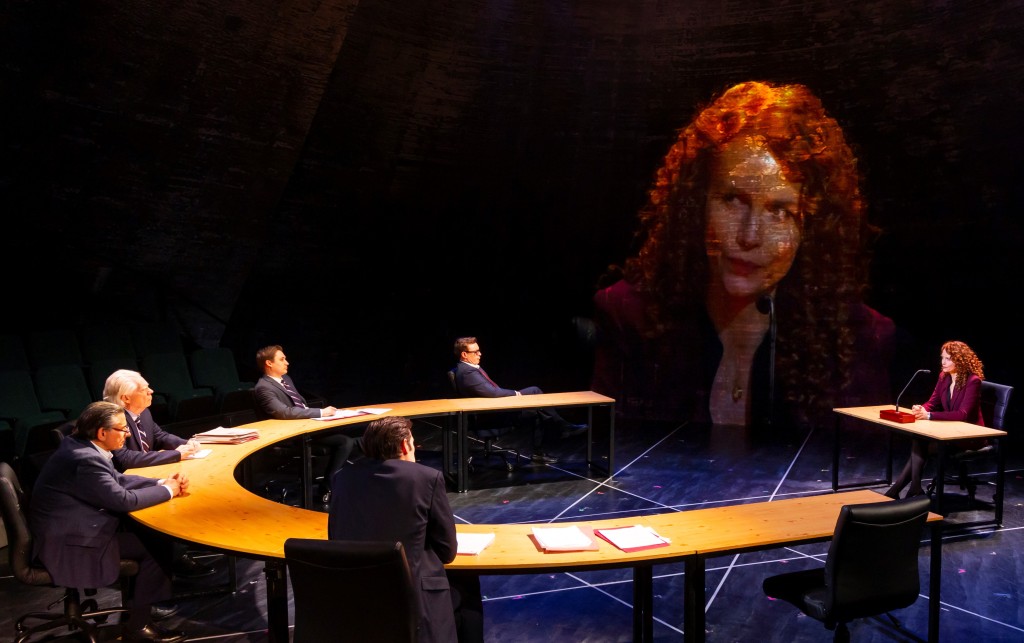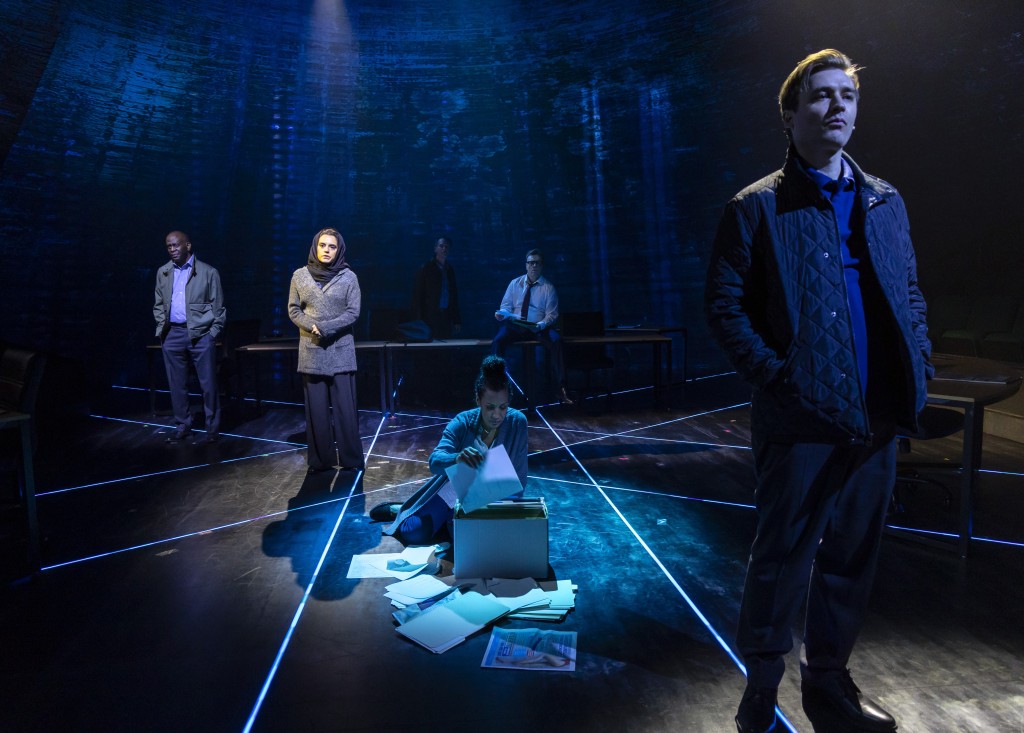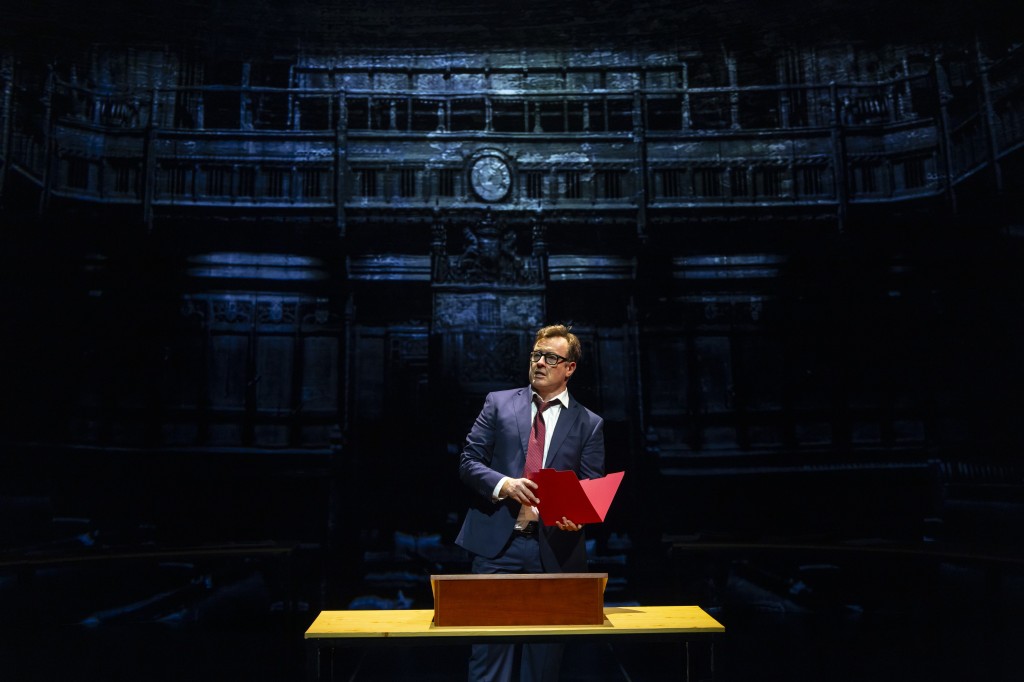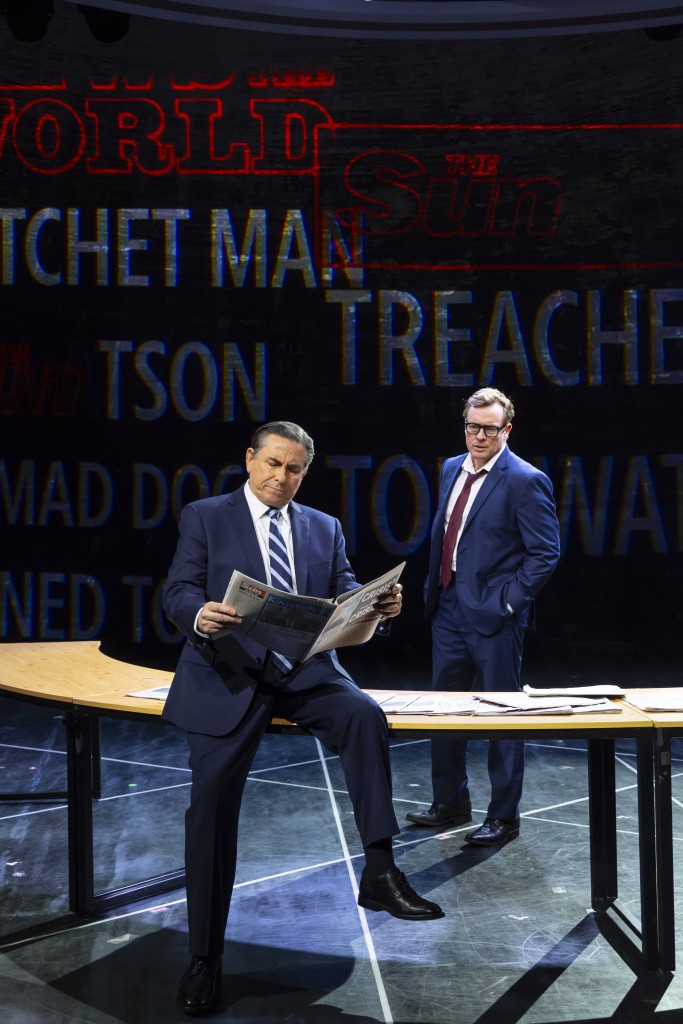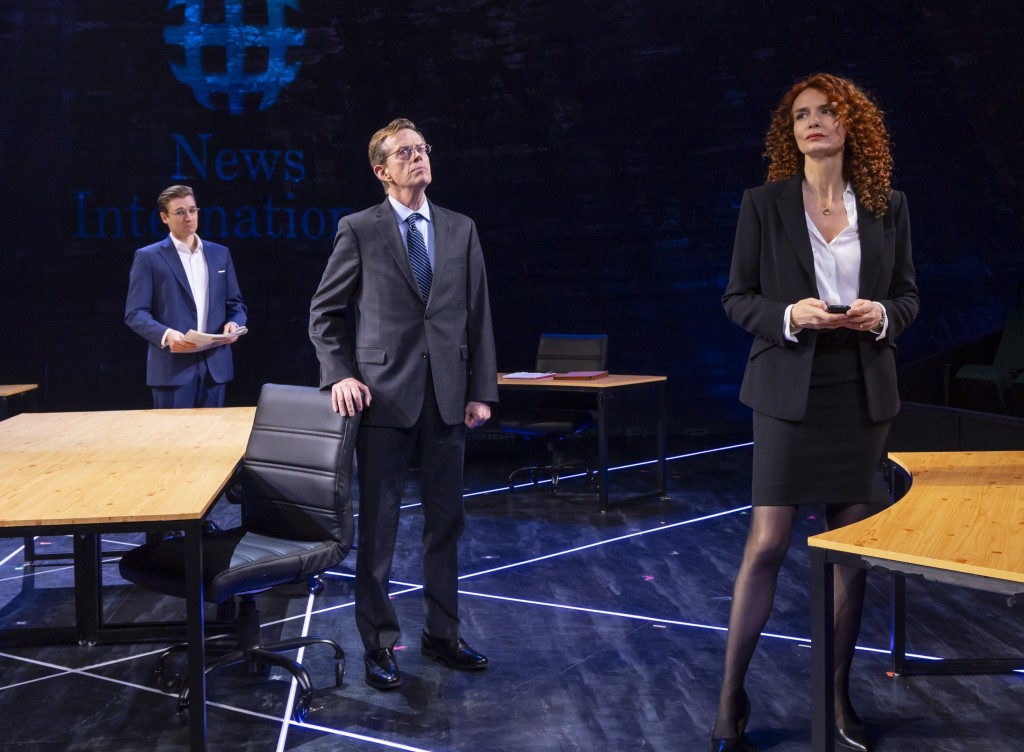Blog Archives
‘The Gardens of Anuncia’ Lyrical, Unique, Fanciful, Directed by Graciela Daniele

In order to deal with the past, sometimes memories must be altered to beautify the ugliness of their reality. This is one of the themes in Michael John LaChiusa’s musical, The Gardens of Anuncia, directed and choreographed by Graciella Daniele. The Gardens of Anuncia is currently running at Lincoln Center’s Mitzi E. Newhouse.
The musical’s picaresque, lyrical journey memorializes the women who inspire and encourage the artistic soul of Annuncia (Kalyn West), as she grows into a teenager, who then will flourish in her global career as a director, choreographer and dancer. The journey intimated is that of Graciella Daniele, Tony Award nominee (ten times), and recipient of a Lifetime Achievement Award. Though she never won a Tony, Daniele’s directing and choreography of Chita Rivera: The Dancer’s Life, Annie Get Your Gun, Marie Christine, Once on This Island, The Pirates of Penzance, and Ragtime, are among her most memorable achievements.
Wisely, LaChiusa focuses not on the public career of Daniele, but on those who grounded the choreographer and director to prepare her to be an overcomer, ready to face obstacles and not be daunted by them. Through present narration by the older Anuncia (the charming, endearing Priscilla Lopez), on the eve of her acceptance of the Lifetime Achievement Award, in the garden of her country house, Anuncia meditates in flashback about her childhood with the three great women who influenced her, making her who she is today. As she readies herself to bury her aunt’s ashes, a final goodbye, she works through her memories, some hurtful, all poignant, growing up in Buenos Aires, Argentina during the Peronista government and movement in the 1940s and 1950s.

Auncia’s memories are vignettes that encompass vital turning points and revelations in the lives of the Younger Anuncia, Tia (Andrea Burns), Granmama (Mary Testa), and Mami (Eden Espinosa), all of them flowers burgeoning in the beautiful garden of her mind. Bounded by the older Anuncia’s narrative, we are introduced in the “Opening” to the women and their routines in the life they live daily in Granmama’s house in Buenos Aires. Together, the women raise the youngster and support each other after Mami and Anuncia are abandoned by Anuncia’s father, referred to as “That Man.” Lyrically, poetically, La Chiusa moves from present to past as the older Anuncia lands on memories that eventually reveal how each of the women traverse the paternalism of a male world and thrive.
The superb Priscilla Lopez (i.e. The Skin of Our Teeth, Anna in the Tropics), originated the role of Diana Morales in A Chorus Line, winning an Obie Award and Tony nomination. Lopez and Kalyn West portray Older Anuncia and Younger Anuncia, playing off one another seamlessly with grace. Through her reflections, the older Anuncia merges with her younger self to gain strength to finally put to rest the pain of the past, manifested in her finally burying her Tia’s ashes. As Lopez brings humor, poignancy, wisdom and loveliness to the older Anuncia, West embodies the innocence, increasing understanding, anger and astuteness when she asks questions and discovers the truth behind the answers that Tia, Grannmama and Mami give her.
From Tia, Young Anuncia learns to use her imagination to explore her world in, “Listen to the Music.” Additionally, Tia explains why she isn’t married and implies that she is happier without being tied down, having to answer and be obedient to a husband (“Smile for Me, Lucia”).

From her mother Mami, she receives the gift of ballet classes to strengthen her flat feet, as well as her interest in the dance. In Espinosa’s interpretation of the sensual “MalaGueña,” Mami dances the tango and sings about the club where she goes to dance with various partners in order to have fun, something that Granmama disapproves of.
Mary Testa’s Granmama adds humor and irony to the relationship the women have with each other. From Granmama, Anuncia learns her love of the dramatic and theatrical, as her Granmama’s reactions are always over the top. Her relationship with her husband, Anuncia’s grandfather, is explosive and extreme. It is forged in scandal and passion, thought it ends up in an eventual tiresome marriage, after which Granmama, eventually kicks him out. In “Waiting/Dreaming,” Anuncia learns they long for each other when he is away in the merchant marine, then can’t wait until he leaves, after a few days of crazy arguments and harangues when he returns.
From each of these incredible women, Anuncia attributes elements of her inner soul. Importantly, she also learns how and why “That Man,” her father, abandoned them and left them destitute, forcing Mami and Anuncia to move in with Tia and Granmama. All of the songs and events take place with the backdrop of danger and “disappearances,” during the Peron regime, a regime which also threatens the family when Mami is arrested.

The events in flashback and flash forward, with Older Anuncia’s narration that bridges them, unspool fluidly in a stylized, minimalist set design by Mark Wendland. The past and present flow into each other in Older Anuncia’s memory, suggested by the ease by which the characters step into the present in the garden of flowers that Older Anuncia talks to, beautifully intimated by Jules Fisher and Peggy Eisenhauer’s lighting design.
The garden is the perfect place of solitude where Old Anuncia revisits conversations and events with these beloved women, who shaped her and sent her with confidence and beauty into the wide world. The colorful, atmospherically lighted beads with attached flowers (Jules Fisher and Peggy Eisenhauer), separate the downstage where the conversations and reminiscences take place, with the past behind the beading where the characters exit.
Lopez, in her direct address to the garden of flowers that includes the audience, animates and enlivens them. Lopez is so specific in her performance, we believe she sees the peonies, the irises, the anemones and forsythias, though nothing is there. However, we note that this is who Anuncia has learned to be, influenced by Tia, to use her imagination.

Thus, in her garden of delights, she is able to converse with the floral pageantry she has planted, as well as the two male deer who come to visit her and nibble on her vegetables. The deer, who are brothers, are hysterically portrayed by Tally Sessions. The first deer gives her the wonderful advice to “Dance While You Can,” as they do a bolero. The second deer, shows up after an interval in time. He shares with the Older Anuncia that he lost his half-brother, who was hit by a car, obeying a “deer crossing” sign. The half-brother is bitter and droll. Lopez’s Anuncia returns the advice she received from the cheerful brother to the nihilistic half-brother, almost cheering him up.
The other male parts are portrayed by Enrique Acevedo who is Granpapa, That Man (Anuncia’s father) and other characters.
Older Anuncia’s garden meditations where she speaks to the plants and the deer are charming, ethereal and magical. They are part of her cultural heritage and legacy from Tia. Like her conversations with Tia, Mami, Grandmama and the others who have passed on, they are a part of her and not “ghosts” or something to be frightened of. The enlivened memories eventually bring the Older Anuncia to closure so that she can finally bury Tia’s ashes. It is time to rest her memories, it is time she lays them in peace in the garden of her mind, manifested in her country house garden.

Daniele directs and stages the actors specifically and acutely so that they seem to create their own geometric patterns and rhythms. The choreography remains simple and evocatively cultural, reflecting the time and place to emphasize the Older Anuncia’s memorialization of the women who are so dear to her. Though West does some ballet, it is more representational, as befits the glimpses into the past, as if Anuncia looks into the mirror and can only bear snippets of reminiscences. Indeed, memories are elusive and questionable. Did certain events happen? There is one that the Younger Anuncia affirms happened and wishes she could forget.
From the lyricism, to the suggestiveness and poetic nuances, LaChiusa’s musical is in a category by itself. As elusive as a butterfly’s shimmering, gossamer wings, The Gardens of Anuncia floats into our consciousness with its poignant softness and seduction with stirring themes about the power of imagination, the profound love conveyed by relatives to strengthen progeny, about legacy, and about the wisdom and love it takes to understand the impact of one generation shepherding the next.

The ensemble are exceptional. They merge, flow, harmonize, dance, spinning into the garden’s loveliness, then retreating back into the corner’s of the Older Anuncia’s mind. Just great!
Kudos go to all the creative team who explored and solidified Daniele’s vision of LaChiusa’s evocative, unique musical. In addition to those mentioned above, these include Toni-Leslie James (costumes), David Lander (lighting design recreation), Drew Levy (sound), Michael Starobin (orchestrations), Deborah Abramson (music director), and Alex Sanchez (co-choreographer).
The Gardens of Anuncia, Lincoln Center Theater at the Mitzi E. Newhouse. Website: https://www.lct.org/shows/gardens-anuncia/
‘Nantuket Sleigh Ride’ by John Guare, Starring John Larroquette, Directed by Jerry Zaks

(L to R Downstage): Adam Chanler-Berat, John Larroquette, Grace Rex (upper level L to R): German Jaramillo, Clea Alsip, Douglas Sills, Will Swenson, Jordan Gilber, Tina Benko in ‘Nantucket Sleigh Ride,’ by John Guare, directed by Jerry Zaks, Mitzi E. Newhouse (T. Charles Erickson)
Sage, pithy, philosophical quotes taken from the stories in Jorges Luis Borges’ Labyrinths serve as the humorous grist that flavors and drives the witty and complex Nantuket Sleigh Ride by John Guare, currently at Lincoln Center Theater’s Mitzi E. Newhouse. The delightful hybrid play (mystery, comedy, fantastical dream-like elements and wonderful “come to life” Rene Magritte painting ‘La Durée Poignardée’ [‘Time Transfixed’]) has an adroitly crafted, labyrinthine structure beautifully clarified with sets and projections by David Gallo and costumes by Emily Rebholtz
Jerry Zaks shepherds the ensemble with an impeccable sense of comedic pacing and precise staging to elucidate the characters and maintain a humorous, coherence throughout, while unraveling the mysteries. The artistic designers with Guare’s and Zaks’ prodigious collaboration help to make Sleigh Ride a whopping, helluva journey through the mind and life of the one-hit playwright Edmund Gowery, during the summer of 1975, a monumental time which changed the course of his life, seemingly forever. From then until the present, Gowery suppressed his artistic sensibilities, left playwriting and sought the empirical, material world of making lots and lots of money.
John Larroquette portrays Gowery with relaxed authenticity and a droll, witty moment-to-moment presence. As Gowery Larroquette navigates remembrances of the summer of 1975, with aplomb. And noting that memory is a filter of age, wisdom and a myriad of emotions, Larroquette deftly filters these-the surprise, upset, fear and concern as he steps from narrator back to the past as actor in his memory. Guare’s vehicle of conveyance using present, filtered memory and past is striking, and Laroquette manages to bridge the changing time referents believably. His older narrative persona channels his youthful self with wry, pointed irony.

Stacey Sargeant, John Larroquette in ‘Nantucket Sleigh Ride,’ directed by Jerry Zaks, written by John Guare (T. Charles Erickson)
We easily accept these filters and joyfully follow Edmund (Mundie) on his madcap, convoluted adventures into the past as he introduces us to a “wicked” cast of characters. These include his mistresses, one of whom cheats on him with her husband (Tina Benko), insidious husbands (Douglas Sills, Jordan Gelber) an earnest, heartbroken lover (Will Swenson), a betraying and betrayed actress wife/lover (Clea Alsip) two kids Poe and Lilac (Adam Chanler-Berat, Grace Rex) the spirit of Jorge Luis Borges who wafts in and out of Mundie’s dreams with salient quotes (German Jaramillo), a cryonically challenged Walt Disney (Doublas Sills), who braves the summer heat of Gowery’s dreams to discuss a venture with him…and a few celebrities.
During the process of remembrance (the events enacted), Larroquette’s Gowery processes the mysterious circumstances of 1975 and grasps the opportunity to blossom into a caring individual who is sensitive to all forms of the truth, especially if it brings peace to others. By the play’s conclusion, through Gowery’s evolution, we understand that some nightmares (reference Borges) can work to one’s advantage, if we are flexible enough to learn from them. With enthusiasm Gowery experiences a resurrection of the artistic and imaginative part of himself. The younger persona which demonstrated a selfishness and self-dealing nature has been drowned reliving the “Nantucket Sleigh Ride.” (No spoiler alert here about what this means. See the play; it’s super.)

(L to R): Clea Alsip, Will Swenson, German Jaramillo, John Larroquette, Tina Benko in ‘Nantucket Sleigh Ride’ directed by Jerry Zaks, written by John Guare (T. Charles Erickson)
How Guare effects this plot structure of present, to flashback past, to dream sequence, to flashback past, to present tweaked with Borges’ tropes and quotes, contributes to the humor and entertaining zaniness of this play with a purpose. The dynamic begins at the top of the play and segues with a usual device which Guare makes more intriguing. Edmund Gowery finishes a congratulatory phone call about his reference as a playwright in the New York Times Sunday crossword puzzle. The symbolism is smart. He’s a clue in a crossword. But who indeed is Edmund Gowery who left off the stresses of success after his first and last Broadway hit Internal Structure of Stars, a “luminous memory play” influenced by Borges?
When his secretary (Stacey Sargeant) brings in his own lost copy of Borges’ Labyrinths (one of the most influential books of Gowery’s life) two frantic adults come into his office: Poe (Adam Chanler-Berat) and Lilac (Grace Rex). Both are pale-faced, limp and emotionally squeezed, but they demand that Gowery tell them about the summer of 1975, which was a time in their lives that was fraught with trauma so severe that they cannot remember what happened to them. For Poe and Lilac it is a “time transfixed.” Their lives cannot resume unless the darkness of the past is lightened with the truth from Gowery’s lips.
The irony is that the summer of 1975 for Gowery also is a “time transfixed,” a disaster which he never worked through, but just circumvented by emotional suppression. If he helps the desperate Poe and Lilac, he must dredge up the nightmares which contributed to the death of his playwriting career and forced him on the unenlightened, yet lucrative path of “convincing people to sell things they love to buy things they don’t want.”

(L to R): John Larroquette, Will Swenson in ‘Nantucket Sleigh Ride,’ directed by Jerry Zaks, written by John Guare (T Charles Erickson)
Running from himself and Poe and Lilac by escaping into the bathroom, Gowery considers. Out of his memory comes Guare’s inimitable, wacky flashback of Gowery’s summer with Poe, Lilac and the others. By the time he decides to give Poe and Lilac what they want, he emerges from the bathroom a more contented man. He has reconciled himself and brought us along as his understanding and empathetic companions. Now, he is able to initiate Poe’s and Lilac’s understanding of their past and move them off the immobilizing still point of trauma.
I enjoyed Guare’s writerly memes and ironic quips, and his use of Borges’ quotes for humor, plot development and revelation of themes. The production is a farcical, mystery romp, but it is also a profound look at reconciliation, second chances, working through trauma and evolving beyond pain if one has the determination to do so.
The two tiered staging as a focal point of elucidation is excellent and the Magritte room, clever. I loved how German Jaramillo’s blind Borges (a truthful metaphor of his inner sight) escorts the chugging locomotive (an element reflective of Borges’ magical realism) off stage as Mundie’s journey moves toward closure of one labyrinth and heads off to lead Gowery into another. The final labyrinth which restores us to the present and Gowery’s lovely reconciliation with Poe and Lilac.
From acting to direction to artistic design (see above and Howell Binkley-Lighting) (Mark Bennett-Original Music and Sound) Nantucket Sleigh Ride delivers. Thanks to the balanced and vibrant work of the ensemble, Larroquette’s wry likeableness, Adam Chanler-Berat and Grace Rex’s humorous transformation from kids to thirty-somethings and the wonderful, stylized German Jaramillo as Borges, this is a must-see for its grace, humor, depth and ironies all of which should not be underestimated.
Nantucket Sleigh Ride runs with one intermission at the Mitzi E. Newhouse at Lincoln Center Theater. For tickets and times go to their website by CLICKING HERE.
‘The Hard Problem’ by Tom Stoppard at Lincoln Center Theater, Reviewing a Profound Work

Chris O’Shea, Adelaide Clemens in ‘The Hard Problem,’ by Tom Stoppard, directed by Jack O’Brien, Lincoln Center Theater (Paul Kolnik)
The Hard Problem by Tom Stoppard initially premiered at London’s National Theatre in 2015. Since then, Stoppard tweaked the play. Director Jack O’Brien has given it another rendering for its New York presentation at the Lincoln Center Theater’s Mitzi E. Newhouse. The production intrigues, heavy with scientific and philosophical intent. When the epiphany arrives at the conclusion, heartfelt emotions stir us. Then we marvel at how Stoppard threaded the interplay of scenes and characterizations into a lovely fabric of hope and the culmination of faith’s efficacy.
As with all Stoppard’s plays, The Hard Problem deals with questions. These include questions about existence, faith, fate vs. coincidence, goodness vs. evil and divinity. He shores up these questions against the backdrop of current scientific debates about the brain vs. consciousness which encompasses what characters refer to as “The Hard Problem.” Indeed, neuroscientists suggest the brain creates consciousness. On the other hand some believe that existence may be characterized by the reverse, that consciousness creates humanity. This latter theory borders on intelligent design, that a greater consciousness formulated the universe and all that it encompasses in its beautifully coherent, complex and infinite display..
Of course much of science opposes the notion of Intelligent Design. And Stoppard presents the thesis antitheses continuum not only in the central questions of the play, but in his extrapolation of themes which playfully present various characters’ “take” on “the hard problem.”
As a result we are led to consider the possibilities of our existence through Stoppard’s sly, humorous perspective. For example one concept posited is that a human being is just a mechanism, a machine whose every cell function can be recorded via empirical data. Thus, after millennia, the evolution of the carbon life forms that currently exist, results from self-dealing and self-interest. Evolution and the idea of machine body survival relies on evolutionary instinct and egocentric action to preserve oneself and one’s species.

Adelaide Clemens (foreground) with Eshan Bajpay (left) and Robert Petkoff, in’The Hard Problem,’ by Tom Stoppard, directed by Jack O’Brien, Linclon Center Theater (Paul Kolnik)
The response to the computer model of existence can easily be breached by the aspect of consciousness. For example where does feeling and emotion come from, our thoughts brewing in the “mind”? Those do not show up on any brain scan or measurement. Science has no answer for what “the mind” and “consciousness” are. It cannot be measured on brain scans when folks in a coma or death states show no brain activity. Yet, if they have come back from that state (and many have) with incredible stories to tell about what happened “over there,” neuroscientists cannot adequately answer with proof. (For a further discussion of this check out the author Eben Alexander.) Looped into these arguments are discussions of ethics and morality, the desire to be good versus the impulse to trod on others to advance In consciousness, where do the impulses toward “ethics” and “morality” generate from when they do appear in human behavior? Do any of us act with altruism? Or is self-benefit the sum total of our “machine” behaviors?
The questions are heady. But Stoppard humorously frames them with events which illustrate the arguments as the characters’ behaviors and actions set them in motion.
As the play opens graduate student Hilary (Adelaide Clemens), and her maths tutor, Spike (Chris O’Shea), debate the impulses of egoism versus altruism, as a preamble to her receiving math help. Hilary has applied for a research slot with The Krohl Institute for Brain Science. Spike reviews the maths on the model she plans to submit in her application. After they have sex, Spike notes that Hilary prays. As a scientist and atheist, he remains shocked that she believes in God. Quips fly back and forth with a brief debate of His existence.

Robert Petkoff (foreground) and Adelaide Clemens in ‘The Hard Problem,’ written by Tom Stoppard, directed by Jack O’Brien, Lincoln Center Theater (Paul Kolnik)
Then Hilary raises “the hard problem” of consciousness. Unable to counter argue adequately, Spike diverts the conversation to helping her with her math. However, they continue to quip about morality, goodness, parenting, mother-love as Spike responds to her presentments with scientific Darwinian explanations for each. She leaves Spike with two comments which slide over him, but we remember for future reference. One thing she prays to God for is forgiveness and her prayers help her. Also, she affirms that to get this plum research position at The Krohl Institute, she needs a miracle.
In these initial scenes reside the conflicts and themes of The Hard Problem. As the intriguing events develop, we note how the characters highlight aspects of Spike and Hilary’s arguments. And as situations spool throughout the play, Stoppard demonstrates the callow, self-serving ethics of the scientific set, loosed from morality, ethics and concerns about divinity or consciousness. Indeed, as they unleash themselves upon the culture, we understand the value of their scientific perspective not “looking for” proof or adequate explication of consciousness. For the utility of humans as machine-like forgoes any measure of dealing with them in a way which is “consciously” kind, decent, moral, ethical, etc.
On the other hand, Hilary and those who believe in being good and evolving toward altruistic behavior, act with noble intentions and equanimity toward others. Of course some of the characters appear to manifest both altruistic and egoistic behaviors in a strange schizoid pattern. An acute example of this is in Stoppard’s characterization of Jerry Krohl, the owner of Krohl Capital and the chief founder of non-profit Krohl Institute for Brain Science.
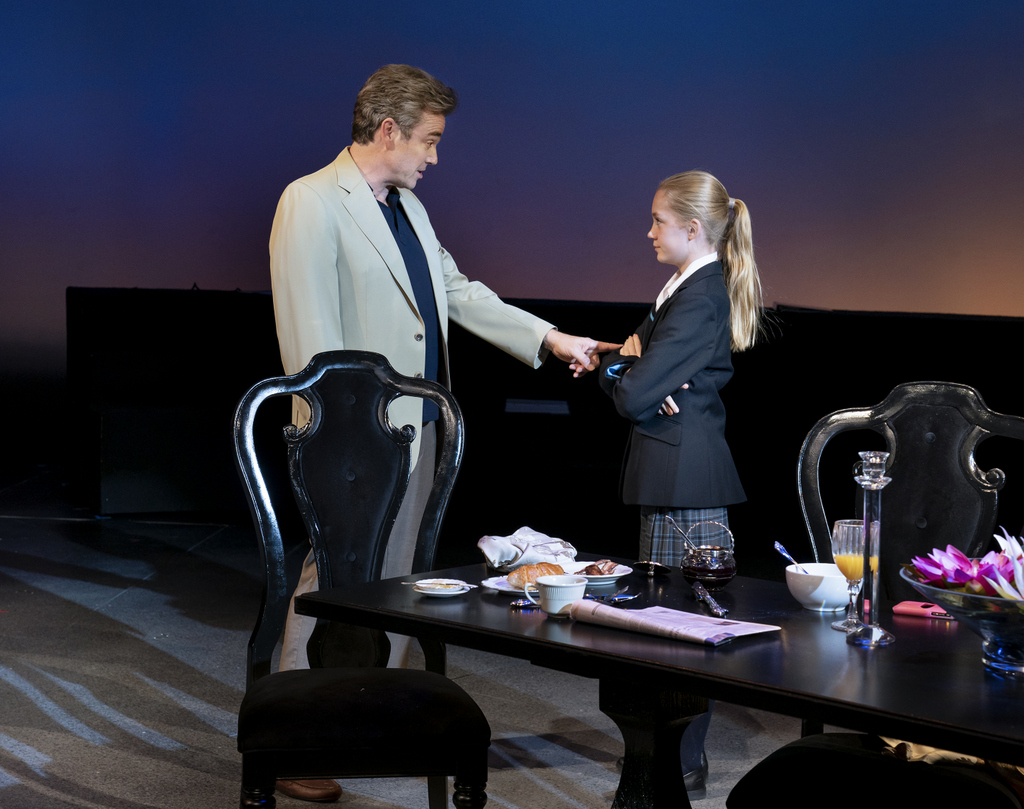
(L to R) Jon Tenney and Katie Beth Hall in ‘The Hard Problem,’ by Tom Stoppard, directed by Jack O’Brien at Lincoln Center Theater, Mitzi E. Newhouse (Paul Kolnik)
Those in agreement with the machine aspect of existence are Amal (Eshan Bajpay), a mathematician, who adheres to Spike’s scientific perspective as does Urusla (Tara Summers). Each shows more than a share of egoism and a lack of fulfillment within. Leo (Robert Petkoff), who selects Hilary for the research position, Bo (Karoline XL), Julia (Nina Grollman) and Cathy (Katie Beth Hall), manifest finer behaviors. Jerry Krohl (Jon Tenney), compartmentalizes both perspectives related to the situation. He remains the perfect example of a moral relativist. When it “is required” for him to be cruel and self-serving to make money, he is. When the occasion requires he be loving, he is. Of course Stoppard reveals by the end of the play why Jerry Krohl has spent oodles of money on his non-profit in addition to the tax deductions his tax accountants most probably set up for him.
Throughout the play, Stoppard develops how Hilary’s perspective and her beliefs eventually lead her to develop as a person who evolves productively toward the moral, social good. We discover why she prays for forgiveness each night. And her ending up for a season to do research at The Krohl Institute for Brain Science leads to a revelation that exceeds coincidence. In a beautiful and satisfying culmination, Stoppard validates Hilary’s assertions about consciousness. Indeed, these manifest in a realm of divine goodness that Hilary seeks. In summation the miraculous finds sway in her life to bring comfort and peace.
That she receives what she prays for appears indeed miraculous against the backdrop of the machine perspectives of science that dismiss a deep understanding of the mind and consciousness. This is no spoiler alert. You will just have to see the production to engage with Stoppards’s humor amidst the profound, the philosophical, the divine.

(L to R): Karoline Xu and Adelaide Clemens in ‘The Hard Problem,’ written by Tom Stoppard, directed by Jack O’Brien, Lincoln Center Theater (Paul Kolnik)
In portraying Hilary, Adelaide Clemens reveals an iron vulnerability and truthful innocence. She smacks down Spike’s manipulations with assurance. She portrays Stoppard’s characterization of Hilary’s strength of will, her openness to the universe, her belief without religious dogma spilling out obtrusively. Clemens’ Hilary is becoming what she intends to be, an empathetic, good individual. We root for Clemens’ Hilary throughout the production. When the blessings come to Hilary, we celebrate with her and are deeply moved.
The ensemble adroitly shepherded by director Jack O’Brien work admirably as Hilary’s foils. O’Shea’s Spike and Bajpay’s Amal remain as the ballast for the arguments and actions presented.
Tenney’s Krohl intrigues with his perfect admixture of kindness with his daughter and cruelty with his underlings. He epitomizes the dark money forces as the ultimate operator of Krohl Capital whose billions come at the expense of others. As a symbol he represents most of the uber wealthy in our culture and reveals how they function. They compartmentalize morality, ethics, love, family. Finely tuning their rapacious greed and harmful, sweeping policies that impair and destroy the lives of many, they turn a blind eye to the results of their behaviors. Like fascism everywhere, they negotiate their own vacuous logic and get others to “buy in.”
Ironically, the scientific culture absent morality, ethics, goodness, absent the nod of assent toward the greater search for a comprehension of “mind,” and “consciousness” can be used as the very “irrational rationale” which justifies harmful sweeping policies set in motion by the uber wealthy and in the processes they employ to accumulate wealth. The perspective of the “machine” view of humanity nullifies the search for the divine in our lives and the acknowledgement that we can be self-less and evolving toward altruism. Instead, that perspective gives a green light for abuse and every attenuating impulse that foments human rights violations.
Stoppard, once again posits this conundrum of consciousness vs. the machine-body model in a pleasing way. The questions his characters raise manifest “the hard problem,” and exemplify, though some have suggested this is too “talky.” However, Stoppard offsets this by revealing the moral implications of the debate while we watch the characters follow their own journeys. Ultimately, we “get” where the dominoes fall for all for the principals, and we rally for those whose humanity and reliance on the “ethereal” compels us. As Stoppard uplifts us away from mechanical, how can we not empathize with Hilary and embrace her noble impulses. Hers is an affirmation of the soul’s flight toward the divine.
The play is one of Stoppard’s most lucid (I know many may disagree with me on this) and most uplifting. Especially in its final culmination, the power of Hilary’s revelation allows us to soar with her on the wings of joy. Our feelings release into the substance of what we seek with her. And it suits for the season.
Kudos to David Rockwell (Sets), Catherine Zuber (Costumes), Japhy Weideman (Lighting), Marc Salzberg (Sound), Bob James (Original Music).
The Hard Problem runs with no intermission at Lincoln Center Theater Mitzi E. Newhouse Theater, until 6 January. Especially if you appreciate Stoppard, do not miss this revelatory new work. You can purchase tickets at their website.
